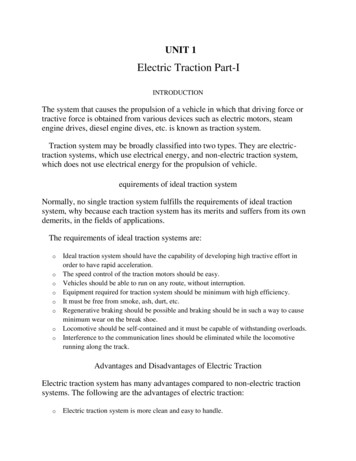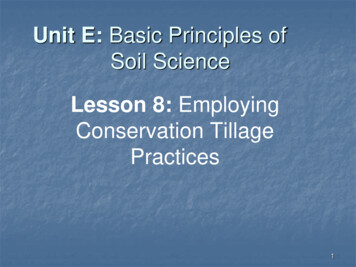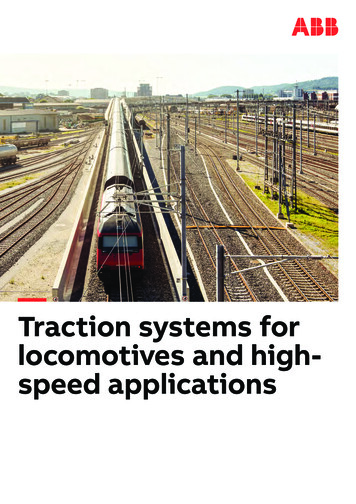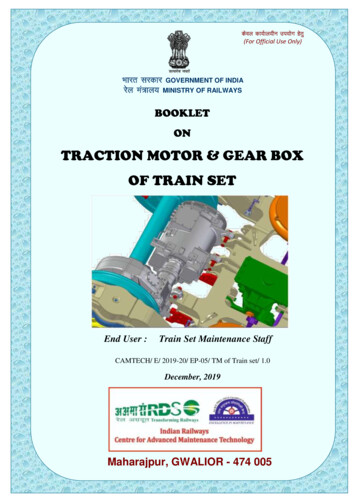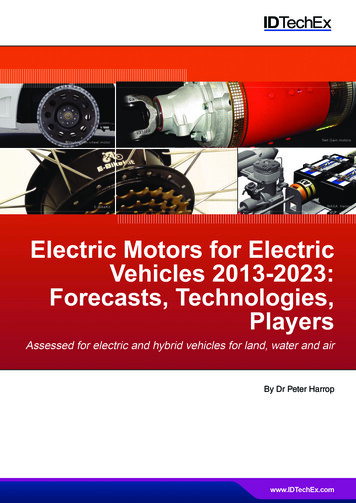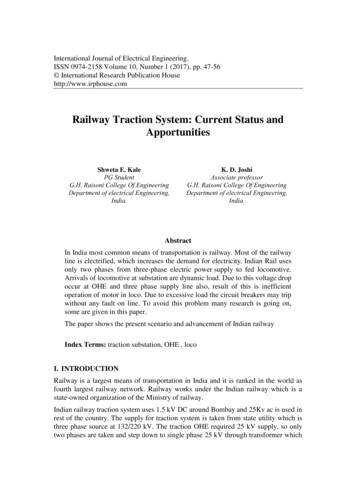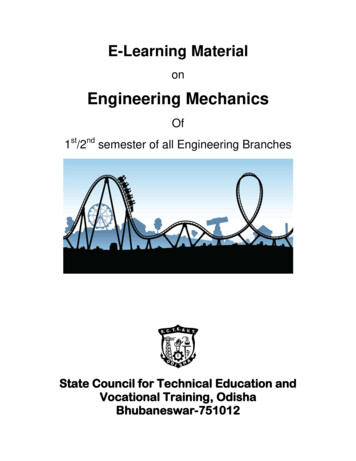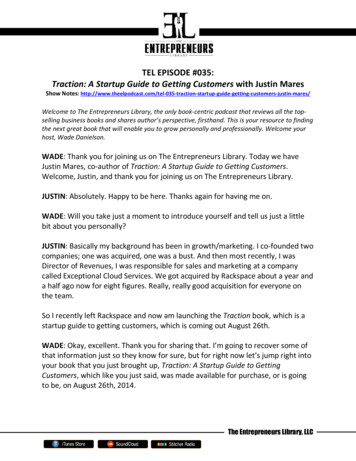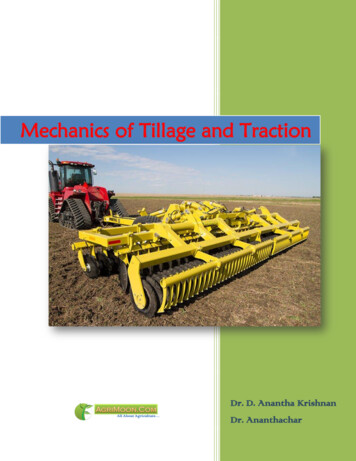
Transcription
Mechanics of Tillage and TractionDr. D. Anantha KrishnanDr. Ananthachar
Mechanics of Tillage and Traction-: Course Content Developed By :-Dr. D. Anantha KrishnanProfessor of Farm MachineryAgricultural Engineering College and Research Institute,TNAU, Coimbatore-:Content Reviewed by :-Dr. AnanthacharDean, College of Agrl. Engg.University of Agricultural Sciences, Raichur
IndexSN1234Lesson1 Introduction to mechanics of tillage toolsHISTORY OF TILLAGESOIL-MACHINE CROP SYSTEMMECHANICS OF TILLAGE TOOLSANALYSIS OF SOIL-MACHINE DYNAMICS IN TILLAGEPage No5-89-1213-1617-182 Engineering properties of soil, principles and concepts, stress strain relationship5PHYSICAL PROPERTIES OF SOILS19-256MECHANICAL PROPERTIES OF SOILS26-317ASSESSMENT OF THE DYNAMIC PROPERTIES OF SOILS32-388ASSESSMENT OF THE DYNAMIC PROPERTIES OF SOILS(continued)39-413 Design of tillage tools, principles of soil cutting9DESIGN OF TILLAGE TOOLS42-4310DESIGN OF TILLAGE TOOLS44-4611MOULD BOARD PLOW SURFACES47-5312PRINCIPLES OF SOIL CUTTING54-644 Deign equation, Force analysis13 DESIGN EQUATION65-695 Application of dimensional analysis in soil dynamics performance of tillage tools14 Dimensional Analysis70-7915 Development of prediction equations80-8216 Methods of dimensional analysis83-8817 Application of dimensional analysis and similitude to soil mechanics89-996 Introduction to traction and mechanics, off road traction and mobility18 Traction100-10419 Traction mechanics105-10720 Off road traction108-1097 Traction model, traction improvement, traction prediction, tyre size, tyre lug, geometryand their effects, tyre testing21 TRACTION MODEL110-11422 TRACTION IMPROVEMENT AND TRACTION PREDICTION115-12023 CONE INDEX AND TIRE BASICS121-12324 TIRES FOR AGRICULTURAL TRACTORS124-129
25 TIRE TERMINOLOGY AND SELECTION OF TIRES130-13526 BALLASTING136-1418 Soil compaction and plant growth, variability and geo statistics, application of GIS in soildynamics27 SOIL COMPACTION142-14428 Mechanical and hydraulic properties of compacted soil145-14829 SOIL PHYSICAL PROPERTIES AND PLANT GROWTH149-15430 MEASURES FOR OPTIMIZING CROP GROWTH BY AVOIDINGEXCESSIVE SOIL COMPACTION155-15531 GEOSTATISTICS / KRIGING156-16032 GIS FOR SOIL VARIABILITY STUDIES161-163
Mechanics of Tillage and TractionMODULE 1. Introduction to mechanics of tillage toolsLESSON 1. HISTORY OF TILLAGE1.1. INTRODUCTIONTillage means the preparation of the growth zone in the soil (about 10 to 90 cm of the top layer of soil)for plant development. As large areas of the surface of the earth are subject to tillage, man has tried toease the cumbersome and time-critical work of tillage and developed machines which allow in mostplaces of the world to perform this task with ease and efficiency.1.2. GENERAL IMPORTANCE OF TILLAGE OPERATIONSThe task of tillage is to prepare soils for productive use. Usually tillage is limited to the arable layer ofsoil, which contains organic matter and where plant life actually can occur. Tillage has to be performedto clear virgin soils of plants and animals for agricultural use. Furthermore, it must be performed tobring the seedlings into the soil and procure for them a good environment for further development.Another objective of tillage is to control weeds and animals living in the soil, such as mice or slugs. Thisis, compared to the use of chemical means, an energy and time consumingway to control pests. Another important point is surface leveling because most operations inmechanized agriculture depend on level surfaces. Irregularities in the soil niveau may be caused bytraffic on the soil, harvesting or climatic effects. Together with this goes the need to distribute clods andporosity according to plant need. The seeds should be covered by small clods for protection whilearound the seeds, fine soil should prevail. Under the seeds, porosity must not be too high, whilesmaller and larger clods should give structure to the soil. Producing this distribution of smaller andlarger clods (stratified seedbed) is one of the main objectives of primary tillage.Producing fine soils for the environment of the seedling and the structure of the seedbed is the mainobjective of secondary tillage and seedbed preparation. Warming up the soil and bringing air to deeperlayers stimulates life in the soil. At the same time, loosening makes it easier for plant roots to penetrateinto deeper soil layers. An optimum porosity will also facilitate the infiltration of air and water for theplant roots, and the ascention of water from deeper soil layers during dry periods. Loosening thesubsoil may be necessary to break up a hardpan, which can be created by trafficking and smearing thebottom of the tillage zone as it happens with plowing or which may develop naturally as in sodopolsoils. Finally, it can be necessary to undertake soil improvements such as bringing down organic matterinto the sterile subsoil or bringing up sand/clay subsoil into arable layers containing too muchsand/clay in their texture.1.3. APPROPRIATE TILLAGE ACCORDING TO SOIL CONDITIONSAn important characteristic of agricultural soil is its texture. It is usual to divide the smallest mineralparticles forming the soil matrix into the three diameter classes of sand (particles between 2 mm and0.05 mm), silt (particles between 0.05 mm and 0.002 mm) and clay (particles smaller than 0.002 mm) [2].Gravel and cobbles (over 2 mm) appear in agricultural soils but are usually unwanted because theymake tillage hazardous and keep little organic matter. Sand-sized and larger particles can be5www.AgriMoon.Com
Mechanics of Tillage and Tractionfractionated by sieving. Silt or clay particles must be estimated by hydrometer or pipette analysis. Soilsare classified into several types, according to the distribution of the three particle size classes.1.4. SOCIO-ECONOMICAL ASPECTS OF TILLAGEResearch carried out in the United States showed that, as the amount of tillage decreases (fromconventional tillage to reduced tillage or no-till), the size and the number of machines decreases andcosts for machinery and labor decrease, too [3]. Major costs are affected by machinery and herbicides.For corn production, the results are summarized below: Ridge-till and no-till are the most profitable systems in different soil types. In all cases mulch-till systems (fall chisel, disk or field cultivator) are more profitable than fallplow but not as good as ridge-till and no-till. In poorly drained soil, ridge-till is more profitable than no-till. Slopes higher than 4% favour notill systems.Time requirements can be reduced by 65% and 43% when replacing conventional tillage with zerotillage and reduced tillage, respectively. At the same time, energy requirements can be reduced frommore than 90 kWh/ha for conventional tillage to about 60 and 10 kW h/ha, respectively, for reducedand zero tillage system. The adoption of soil conservation tillage systems suffers from manyconstraints, particularly in developing areas: Lack of financial means (difficult procedures to obtain credits and subsidies, high interest rates). Climatic conditions impose more risks with the new tillage systems. Low technical level of farmers due to lack of research and extension.In developed countries, energy and labor saving and the protection of soil and water from pollutionand degradation are the major aspects connected with tillage. The search for adapted systems assumesthat the user‘s technical level and the farmer‘s financial funds are taken into account. A simulationbased on data of an investigation carried out in Morocco shows that the cost of direct seeding is lessthan for other tillage systems if the annual planted surface is larger than 60 ha. There is an urgent needto introduce sustainable agriculture in fragile ecosystems, particularly in the developing countrieswhere low-input farming increases the environmental degradation and perpetuates low yields and lowrevenue.1.5. HISTORY OF TILLAGEFor thousands of years of recorded history, groups of human beings have been tilling the soil in orderto increase the production of food. Early evidence indicates that simple light weight wooden ploughs,for instance, were employed extensively in the valleys of the Euphrates and Nile rivers by the year 3000B.C. Animals in the form of oxen provided the traction necessary to pull the ploughs, preparing the soilfor the seeding of barley, wheat and flax crops, (Encyclopedia Brittanica, 1979). The ploughs usedduring that period had no wheels or mould boards with which to invert the soil and prepare a trueplough furrow. Nevertheless, they served to perform an initial breakup of the soil to a shallow depthand subsequently to cover the seeds of the crop. An example of an early Egyptian wooden plough isdepicted in figure 1.6www.AgriMoon.Com
Mechanics of Tillage and TractionFig 1. Early wooden plough, Thebes, Egypt, Cirea 3000It was more than 200 years ago that the first iron ploughs were fabricated in Northern Honan, China.At first these were small hand-drawn tools having a flat V-shaped iron piece attached to a woodenblade and handles. During the first century B.C., water buffaloes were used to pull tillage implements.Subsequently, triple-shared ploughs, plough-and-sow instruments and harrows were developed.Ploughs have been used also in India for thousands of years. Early implements had no wheels ormould board, being composed of wedge-shaped hard wood blocks, and pulled by bullock. The soil wasbroken into clods but not turned over, and this primary tillage was followed by the passage of arectangular wooden beam, also drawn by bullock, for the breaking of clods and leveling of the seedbed.Iron plough shares appeared on Roman ploughs about 200 years ago, as well as cutting coulters knives.Still no mould board was used to turn soil cover. These ploughs were pulled by teams of oxen, up toeight per team on a heavy soil with high strength. There were reports, but no solid evidence, thatploughs equipped with wheels appeared in Northern Italy around 100 A.D.Wheels, cutting coulters and mould boards all were included on ploughs in Europe by the year 1500A.D., as shown in figure 2. These implements could invert the soil and make true furrows and a trueseed bed. High ridges of soil were left in the fields, some of which remain in evidence today. Ratherthan chest yokes for animals to pull tools, padded horse collars, apparently invented in China, wereattached to horses. This innovation significantly improved the animal‘s ability to provide draft force.Reams of two, four, eight and more horses or oxen were often used in primary soil cultivation,depending on the strength of the soil to be tilled.Tillage implements very similar to those now in use began to appear with the introduction of theRotherham plough in the Netherlands, England and Scotland by the early 1700‘s. The principal designfeatures of this implement remain virtually unchanged today. Also in the 18 th century, Jethro Tullpromoted the use of horse-drawn cultivating hoes in wide crop row spacing. The purpose of this7www.AgriMoon.Com
Mechanics of Tillage and Tractiontechnique was to destroy weeds competing with crops and to keep the soil in between the rows in agood crumbly and friable condition for water infiltration.More than 100 years later, Robert Ransome patented a cast-iron plough share in 1785, and a selfsharpening share in 1803. Later he introduced standard parts for tillage implements which could bereplaced in the field, and a double shared plough. Around the same time, the practice of ―mole‖ploughing began in United Kingdom to provide subsurface drainage channels in wet fields. Thistechnique is accomplished with deep soil cutting ―leg‖ trailing a bullet-shaped mole at the base, whichleaves continuous tube-like cavities in certain plastic soils, and greatly improves the internal drainageof wetlands.On the American organic prairie soils, problems of satisfactory tillage induced John Deere, an Illinoisblacksmith, to develop a steel plough with a one piece share and mould board in the 1830‘s. Animalpower for traction began to wane with the introduction of the steam powered tractor in the 1860‘s,beginning with the larger farm operations. The first gasoline powered tractor appeared in the UnitedStates in 1892, and many manufacturers were producing these machines in Europe and America withina few years. The steel wheels on tractors began to be replaced by rubber tires in 1932, and by 1968 itwas estimated that there were over 15 million tractors in the world.***** *****8www.AgriMoon.Com
Mechanics of Tillage and TractionLESSON 2. SOIL-MACHINE CROP SYSTEM2.1. INTRODUCTIONSoil dynamics is the branch of knowledge that considers the motion of soil. Soil dynamics, a phase ofsoil science and mechanics concerned with soils in motion, may be defined as the relation betweenforces applied to the soil and the resultant soil reaction. This definition does not restrict the source ofthe force applied to the soil; consequently, the dynamic reactions that result from the natural forces ofwind, water, and other sources are also included in the definition. Reactions due to wind and water areof paramount importance in erosion and hydrology and the mechanics of these reactions are beingstudied. However, reactions caused by mechanical forces applied directly to the soil are considered inthis course. The dynamic reactions of soil in tillage and traction affect the design and use of machinesthat handle soil. Because of the primary interest in the interrelations, the tool (or traction device) andthe soil must be considered together.Soil movement results from man's attempts eitheri. to change prevailing soil conditions to those that are more suitable, orii. to use soil for support, and locomotion of vehicles.The scope of soil dynamics thus includes soil-machine relations in both tillage and traction. It is notrestricted to agricultural soils and problems since information on basic soil behavior is universallyapplicable.The tremendous amount of earth construction and land forming throughout the world has mademachine handling of soil increasingly important in construction, military, and mining operations. Thefinal applications of soil dynamics knowledge may differ, but the principles are independent ofapplication.2.2. SOIL-MACHINE-CROP SYSTEMThe machine, which can be a tillage implement, traction device, planter, fertilizer applicator, excavatoretc., is used to change the soil condition by breaking it up or compacting it. In reaction, the soil offerssome resistance to the machine resulting in wear and tear, high energy demand and hence highproduction cost. By analyzing the soil-machine interaction, it is possible to optimize this process. Onthe other hand, the soil provides the environment which the crop requires for growth. In so doing, thecrop also replenishes the soil with organic matter or depletes nutrients in the soil.Analysis of the soil-crop system ensures optimization of crop yield and at the same time ensuringsustainability in terms of soil and water conservation, and energy conservation. The field of soildynamics has been developed to identify various subsystems namely, machine, soil and crop, identifyvarious parameters for each subsystem and to explain the interactions among the machine, soil andcrop.9www.AgriMoon.Com
Mechanics of Tillage and TractionThe machine is usually characterized by a number of parameters namely,i. draught required,ii. energy required,iii. speed of operation,iv. width of operation,v. depth of operation, andvi. rake angle.The soil is characterized by,i. cohesion,ii. structure,iii. angle of internal friction,iv. cone index,v. dry density, andvi. soil nutrients.The soil-metal interface is characterized by,i. angle of soil-metal friction,ii. adhesion,iii. wear factors etc.The crop is characterized by,i. germination,ii. weed infestation,iii. leaf area index, andiv. yield.Analysis of the entire system and the subsystems provides the tool to predict the performance of themachine, crop and soil. The main aim of soil dynamics analysis is to conserve energy, soil, and water,then ensuring high yields at low costs and sustainability of production.10www.AgriMoon.Com
Mechanics of Tillage and Traction2.2.1. TillageTillage refers to the mechanical manipulation of the soil in order to provide the conditions necessaryfor crop growth. In conventional crop production systems, tillage accounts for over 50% of the energyexpended from land clearing to harvesting. Therefore, in trying to improve productivity of cropproduction, more efforts should be devoted to improving the productivity of tillage operations. Sincethese conditions vary with crop and soil conditions, it is important to study the different aspects of soilmachine-plant system in order to minimize the deleterious effects of the interaction among the threemain components of the system (soil, machine and crop).In a classical modern production system, a machine is used to manipulate the soil in order to providethe conditions required for the crop to grow.The conditions required for favourable crop growth may include: weed control, providing desired soil structure, incorporation of residues, preparation of land for irrigation, mixing fertilizer and other soil amendments into the soil and destroying insects, pest etc.Because of the various requirements, soil type and condition, there are various tillage methodscovering a wide spectrum from zero tillage to conventional tillage. Whatever the type of tillageadopted, the interactions can be understood by looking at the soil – machine – crop subsystems as acomplete system in itself. This is illustrated in Fig. 1.1.11www.AgriMoon.Com
Mechanics of Tillage and TractionAny tillage operation is basically a dynamic process. Movement of soil particles during a tillageoperation is the result of the application of force by a tillage tool. The soil fails due to the action of theapplied force, and soil particles move in various directions. The tool geometry, operating speed, andsoil physical properties are important factors influencing the soil movement.2.2.2. TractionTraction is the force derived from the soil to pull a load. This force is exerted against the soil by atraction device such as a wheel, track, winch sprag, or spade. The dynamic resistance of the soil toprovide traction is supplied through an interaction between the traction device and the soil. Thisinteraction is very complex and little headway has been made in solving some of the problems thatresult from the interaction.2.2.3. Tillage toolsTillage tools are mechanical devices that are used to apply forces to the soil to cause some desiredeffect. The desired effects that can be produced by a tillage tool are:i. pulverization of the soil,ii. cutting of the soil,iii. inversion of the soil, andiv. movement of the soil.Tillage tools usually produce several effects simultaneously. The ultimate aim of tillage is tomanipulate a soil from a known condition into a different desired condition by mechanical means.***** *****12www.AgriMoon.Com
Mechanics of Tillage and TractionLESSON 3. MECHANICS OF TILLAGE TOOLS3.1 MECHANICS OF TILLAGE TOOLSThe objective of mechanics of tillage tools is to provide a method for describing the application offorces to the soil and for describing the soil‘s reaction to the forces. An accurate mechanics wouldprovide a method by which the effects could be predicted and controlled by the design of a tillage toolor by the use of a sequence of tillage tools. Furthermore, the efficiency and economy of the tillageoperation could be evaluated from the mechanics. A thorough knowledge of the basic forces andreactions is required to develop the mechanics. Such knowledge is not available at present, and soilreactions cannot even be predicted, let alone controlled. As a result, an operation is performed, theconditions are arbitrarily evaluated, and additional operations are performed in sequence until theconditions are adjudged to be adequate. Thus, today, tillage is more an art than a science.Mechanics of tillage tools have been developed where simple tools or simple actions are involved andwhere forces and reactions can be described. This chapter presents several approaches that have beenused to develop simple forms of soil-tillage tool mechanics. Only homogeneous soil conditions areconsidered. Although this approach is completely unrealistic, it does not negate the results of thestudies. Complete knowledge of reactions for a homogeneous soil will provide a basis for solvingproblems dealing with layered soils. Interactions of importance will probably occur, but they shouldnot present insurmountable obstacles. The approaches discussed in this chapter do not represent anyfinal solution of the problems that are posed. The approaches, however, do represent those that havebeen utilized and those that may contribute to the development of a successful mechanics of tillagetools.3.1.1. The Reaction of Soil to Tillage ToolsThe reaction of soil to a tillage tool can be quantitatively described only by a mechanics. The soil can bevisualized as a continuous semi-infinitive mass composed of air, water, and solids arranged in somehomogeneous manner. As a tool advances in the soil, the soil reacts to the tool and some action occurs.For example, the soil may move as a mass, the solids may displace the air or water, or the solids maybreak apart. The action of the soil‘s response can be described by such qualitative terms as plowing,cultivating, and harrowing. When a quantitative description is desired, however, numbers mustreplace the qualitative terms.The behavior equations were developed to quantitatively describe simple reactions of the soil to forcesand also to define dynamic parameters that assess the soil. Behavior is defined here as anyphenomenon that can be identified, isolated, and studied so that a behavior equation can be written toquantitatively describe the phenomenon. Thus, if an action such as plowing can be represented by thesimultaneous occurrence of phenomena represented by behavior equations, a possible means isavailable for developing the desired quantitative description. Incorporating behavior equations into asystem of equations that describes an action for a specific set of circumstances is one way to develop amechanics. The equations of the mechanics will provide the desired quantitative description.3.1.2. Principles for Developing Mechanics13www.AgriMoon.Com
Mechanics of Tillage and TractionThe steps involved in the development of mechanics based on behavior equations are:i. The action to be quantitatively described must be defined.ii. The behavior involved in the action to be described must be recognized.iii. In most circumstances the behavior must be incorporated into a mechanics that describes the action.The action to be described is defined by interest from outside the action. A problem to be solved,curiosity, or merely a quest for knowledge are sources of interest. In the example of the projectile,interest determines whether the path of motion of each mathematical point of the projectile must bedescribed or whether only the path of motion of the center of mass must be described. No setprocedure can be established for defining an action because the procedure usually embodies simplydefining the problem. Personal interest and the nature of the action itself will influence the definition.Until the action (defined here as the doing of something) has been at least qualitatively defined,however, the problem of quantitatively describing the action cannot be undertaken.Because no unique structure exists, because of the mathematical complexity of the structure, andbecause more than one behavior is always involved, two guidelines for choosing behavior involved inan action are indicated. First, the choice of behavior must be arbitrary. In other words, for any specificaction most of the behavior can be ignored. Second, the mathematical complexity suggests choosingbehavior where the inputs and outputs of the behavior equation are as close as possible to the factorsthat will describe the action. For example, stress and strain do not lend themselves to describing thepath of motion of a projectile.When more than one behavior equation is required, a mechanics is required to combine the behaviorequations. Just as no specific procedure can be given for defining an action, so no specific procedurescan be given for combining behavior equations. Each situation has its own peculiarities. As suggestedin the example of the projectile, including a second behavior equation may so change the result of themechanics that little similarity remains. While the details of procedure will vary, combining behaviorequations usually involves considering the equations simultaneously with boundary conditions.Simultaneous solution of the system of equations results in the desired mechanics.3.1.3. The Complete Soil-Tillage Tool MechanicsThe reactions of soils to forces applied by tillage tools are affected by the resistance to compression, theresistance to shear, adhesion (attraction forces between the soil and other material) and frictionalresistance. These are all dynamic properties in that they are made manifest only through movement ofsoil. Acceleration forces are not a property of soil but are also present. Nichols has shown that reactiveforces of all classes of soils are dominated by the film moisture on the colloidal particles and are thusdirectly related to the soil moisture and colloidal content.By following the principles, a soil tillage tool mechanics can be developed in progressive stages (fig.1.1).The purpose of the mechanics is to quantitatively describe the action of tillage on the soil. In the initialrecognition phase, the action is observed and noted to be repetitive. The recognition phase is graduallysupplanted by a qualitative phase, in which the general forces are identified and specific reactions areobserved. Nearly all of the world‘s literature on tillage research falls into the qualitative phase asdefined here. The tool size and shape, width and depth of operation, speed of operation, and soilconditions are varied and the soil reaction is noted. The procedure involves trial-and-error methods of14www.AgriMoon.Com
Mechanics of Tillage and Tractionsolving problems. The qualitative phase has been habitually utilized for problem-solving purposes;unfortunately, relations based on trial-and-error results rarely explain the underlying basic principles.Hence, the relations generally may not be used to satisfactorily explain new and untried situations, andmore trial and error studies must be made.3.2. TILLAGE TOOL DESIGN FACTORSThe purpose of the tillage tool is to manipulate a soil as required to achieve a desired soil condition.There are three abstract design factors namely, i. initial soil condition, ii. tool shape and, iii. manner oftool movement. These three design factors control or define the soil manipulation. The results of thesethree input factors are evidenced by two output factors, namely, i. the final soil condition and, ii. theforces required to manipulate the soil. All five factors are of direct concern to a tillage implementdesigner.Of the three input factors, the designer has complete control only on the tool shape. The user may varythe depth or speed of operation and may use the tool through a wide range of soil initial conditions.However, tool shape cannot be considered independently of the manner of movement or initial soilcondition. The orientation of a tool shape with respect to the direction of travel must be defined.Different initial soil condition sometime requires different shapes. For example many different shapesof the mould board plows has been developed for different soil types and conditions.The shape that is of concern in design is the surface over which the soil moves as a tillage tool isoperated. Gill and Vanden Berg classify three shape characteristics as i. macroshape, ii. edgeshape andiii. microshape. The term macroshape designates the shape of the gross surface. The edgeshape refers tothe peripheral and cross-sectional shape of the boundaries of the soil working surface. Notched andsmooth disk blades have different edgeshape but the macroshape may be the same. The microshapesrefer to the surface roughness.Most tillage tool have been developed by cut-and-try methods on the basis of qualitative analysis. Themanipulation-shape relation has received has greatest emphasis in the development of the mouldboard plow bottoms, whereas force shape relations have been of concern in subsoilers and chisel typetools. Mathematical description of the shapes are the most versatile means of representation, but toolssuch as mouldboard plough have complex shapes that cannot easily be representative in mathematicalform. Graphic representation is often employed for plow bottoms, although mathematical analysis hasbeen attempted and computer analysis of plow-bottom shapes is increasing.The shape of the cutting edge can materially affect draft as well as vertical and lateral components ofsoil forces. For example, disk blades sharpened from the concave side penetrate more readily thanblades sharpened from the convex side. Worn plowshares reduce the vertical downward force V, tendto cause soil compaction, and sometimes substantially increase draft.The roughness of a surface over which soil slides (microshapes) influences friction forces. Surfaceroughness is related to the initial polish and the effect of abrasive wear, and may result locally from therust, scratches, or small depressions. Frictional resistance can account for as much as 30% of the totaldraft of a mould board plow. Microshapes can also have an important effect on other aspects of soilmovement, such as scouring.3.2.1. ScouringOne of the most important aspects of sliding action of soil is scouring of a tool while it is being
18 Traction 100-104 19 Traction mechanics 105-107 20 Off road traction 108-109 7 Traction model, traction improvement, traction prediction, tyre size, tyre lug, geometry and their effects, tyre testing 21 TRACTION MODEL 110-114 22 TRACTION IMPROVEMENT AND TRACTION PREDICTION 115-120 23 CONE INDEX AND TIRE BASICS 121-123
